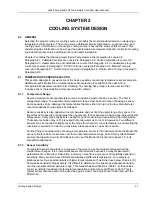
Lake Shore Model 332 Temperature Controller User’s Manual
1.1 PRODUCT
DESCRIPTION
The Lake Shore Model 332 Temperature Controller creates a new standard for high-resolution
temperature measurement in an easy-to-use temperature controller. The Model 332 offers high
resolution with negative temperature coefficient (NTC) resistance temperature detectors (RTDs) to
temperatures as low as 1 K. The Model 332 includes a 50 W heater output on the first control loop
and 10 W on the second control loop. This provides greater flexibility in applications that require a
second heater.
Sensor Inputs
Automatic scalable excitation current allows the Model 332 to support Cernox™ and other NTC RTDs
to temperatures as low as 1 K. At higher temperatures, where resistance is low and concerns for sensor
self-heating are minimal, the Model 332 provides an excitation current of 1 mA for a better signal to
noise ratio and high-measurement resolution. At low temperature, where resistance is high (up to
75 k
Ω
), the Model 332 provides an excitation current of 1 µA to minimize sensor self-heating and
self-heating induced error. Excitation currents of 10 µA and 100 µA are also available. Manual control of
the excitation range is available, making it possible to fix the input range. The Model 332 also uses
current reversal to eliminate thermal electromotive force (EMF) errors.
The Model 332 Temperature Controller features two inputs, with a high-resolution 24-bit analog-to-
digital converter and separate current source for each input. Sensors are optically isolated from other
instrument functions for quiet and repeatable sensor measurements. Sensor data from each input can
be read up to ten times per second, with display updates twice each second.
Standard temperature response curves for silicon diodes, platinum RTDs, and many thermocouples are
included. Up to twenty 200-point CalCurves™ for Lake Shore calibrated sensors or user curves can be
loaded into non-volatile memory via computer interface or the instrument front panel. A built-in
SoftCal™ algorithm can also be used to generate curves for silicon diodes and platinum RTDs, for
storage as user curves.
Sensor inputs are factory configured and compatible with either Diode/RTD or Thermocouple sensors.
The choice of 2 Diode/RTD inputs, 1 Diode/RTD input and 1 Thermocouple input, or 2 Thermocouple
inputs must be specified at time of order. The configuration cannot be changed in the field. The
software selects the appropriate excitation current and signal gain levels when the sensor type is
entered via the instrument front panel.
The Diode/RTD input configuration is compatible with most diode and negative and positive
temperature coefficient RTDs. Current reversal eliminates thermal EMF errors for resistor sensors.
The Thermocouple input configuration is compatible only with thermocouple sensors. Room-
temperature compensation is included for any type of thermocouple in use. Temperature response
curves for many types of thermocouples are included. Temperature response curves may be entered
as user curves for other thermocouples.
The Lake Shore SoftCal algorithm for silicon diode and platinum RTD sensors is a good solution for
applications that need more accuracy than a standard sensor curve but not traditional calibration.
SoftCal uses the predictability of a standard curve to improve the accuracy of an individual sensor
around known temperature reference points.
Temperature Control
For the greatest flexibility in temperature control, the Model 332 has two independent, proportional-
integral-derivative (PID) control loops that drive two heater outputs of 50 W and 10 W.
A PID control algorithm calculates control output based on temperature setpoint and feedback from the
control sensor. Wide tuning parameters accommodate most cryogenic cooling systems and many small
high-temperature ovens. Control output is generated by a high-resolution digital-to-analog converter for
smooth, continuous control. A manual control mode is also included.
1-2
Introduction













































